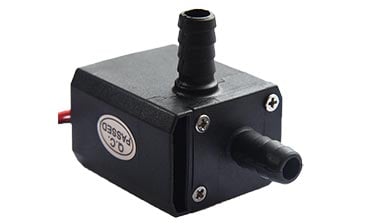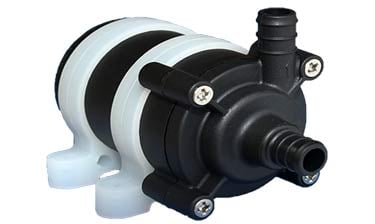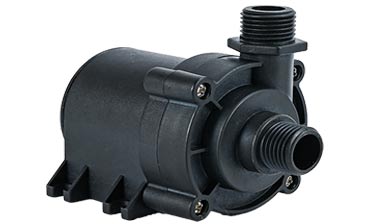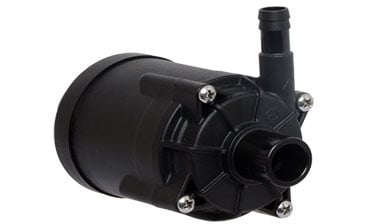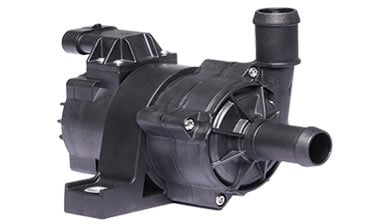Electric Coolant Pump
Home > Electric Coolant Pump
Electric Coolant Pump
Electric coolant pump is a 12v 24v or 48v automotive electric water pump that use centrifugal force to pressurize and sends coolant, antifreeze on a circulation journey through the electric vehicle battery block or engine block for dissipation of heat for car engine, power battery, etc. It plays a key role in automobile cooling system.
Engine coolant pump is a small water pump driven by a 12v, 24v or 48v brushless dc motor. Usually powered by battery and used as a battery powered water pump in new energy buses, and new energy vehicles etc. It is small in size, high in efficiency, usually used for automobile’s engine cooling, new energy bus, new energy vehicles battery circulation cooling, etc. It pressurizes the coolant to ensure the coolant circulates in the cooling system. A popular view is that : Engine coolant pump pumping the coolant continuously circulate in the radiator engine block, and take away the heat to ensure that avoids high temperature to damage the engine.
Standard Electric Coolant Pumps Series by VOVYO:
-
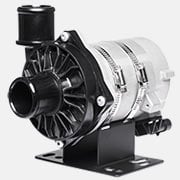 VP90A
VP90A -
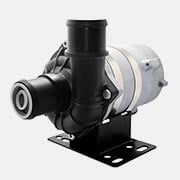 VP90B
VP90B -
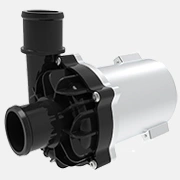 VP90C
VP90C -
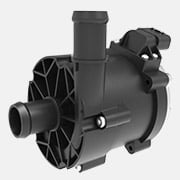 VP80A
VP80A -
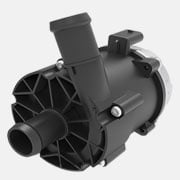 VP80B
VP80B -
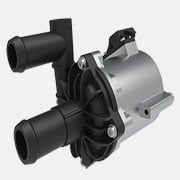 VP80C
VP80C -
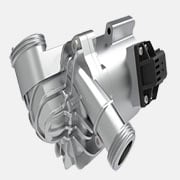 VP80D
VP80D -
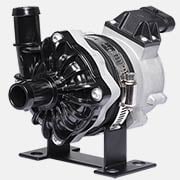 VP80E
VP80E -
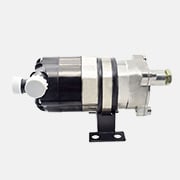 VP75A
VP75A
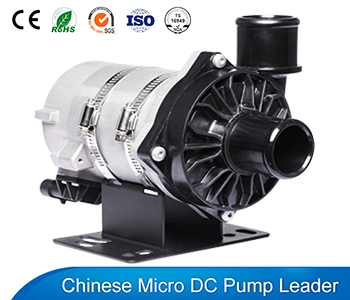
Main Parameters (VP90A)
| Rated Voltage: | 24V/24V |
| Max Static Head: | 24 Meters / 25 Meters |
| Max Flow Rate: | 6000L/hour / 6600L/hour |
| Inlet Outer Diameter: | Φ38mm |
| Outlet Outer Diameter: | Φ38mm |
| Liquid Temperature: | -40°~125°C |
| Certificates: | ROHS,CE |
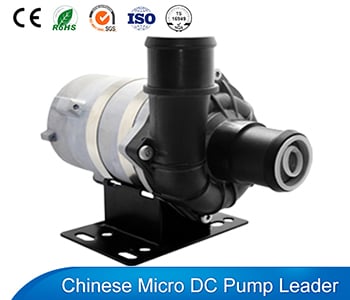
Main Parameters (VP90B)
| Rated Voltage: | 24/24V/24V |
| Max Static Head: | 6 Meters / 9 Meters / 11 Meters |
| Max Flow Rate: | 9000L/h / 9000L/h / 9900L/h |
| Inlet Outer Diameter: | Φ38mm |
| Outlet Outer Diameter: | Φ38mm |
| Liquid Temperature: | -40°~125°C |
| Certificates: | ROHS,CE |
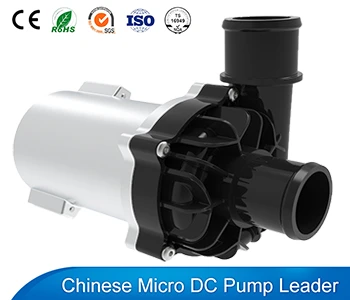
Main Parameters (VP90C)
| Rated Voltage: | 24V/24V |
| Max Static Head: | 9 Meters / 9 Meters |
| Max Flow Rate: | 9000L/h / 10800L/h |
| Inlet Outer Diameter: | Φ39mm (thread) |
| Outlet Outer Diameter: | Φ39mm (thread) |
| Liquid Temperature: | -40°~125°C |
| Certificates: | ROHS,CE |
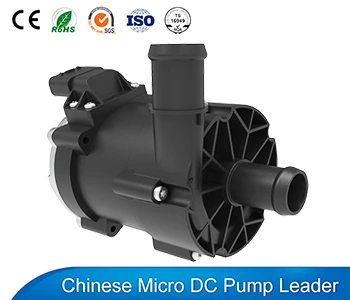
Main Parameters (VP80A)
| Rated Voltage: | 12V/12V/24V |
| Max Static Head: | 9 Meters/12 Meters/12 Meters |
| Max Flow Rate: | 41L/Min / 48L/Min / 48L/Min |
| Inlet Outer Diameter: | Φ20mm |
| Outlet Outer Diameter: | Φ20mm |
| Liquid Temperature: | -40°~125°C |
| Certificates: | ROHS,CE |
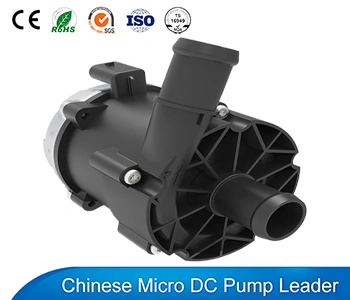
Main Parameters (VP80B)
| Rated Voltage: | 12V/24V |
| Max Static Head: | 9 Meters / 9 Meters |
| Max Flow Rate: | 41 L/Min / 41 L/Min |
| Inlet Outer Diameter: | Φ20mm |
| Outlet Outer Diameter: | Φ20mm |
| Liquid Temperature: | -40°~125°C |
| Certificates: | ROHS,CE |
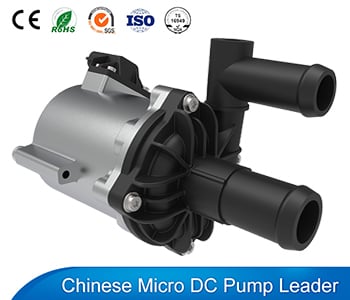
Main Parameters (VP80C)
| Rated Voltage: | 13.5V/24V |
| Max Static Head: | 9 Meters / 9 Meters |
| Max Flow Rate: | 46L/Min / 46L/Min |
| Inlet Outer Diameter: | Φ26.5mm |
| Outlet Outer Diameter: | Φ22mm |
| Liquid Temperature: | -40°~125°C |
| Certificates: | ROHS,CE |
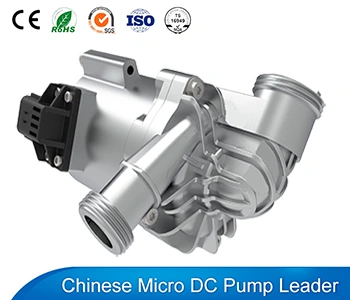
Main Parameters (VP80D)
| Rated Voltage: | 13.5V/24V |
| Max Static Head: | 10 Meters / 10 Meters |
| Max Flow Rate: | 50L/Min / 50L/Min |
| Inlet Outer Diameter: | Φ25mm (thread) |
| Outlet Outer Diameter: | Φ17mm (thread) |
| Liquid Temperature: | -40°~125°C |
| Certificates: | ROHS,CE |
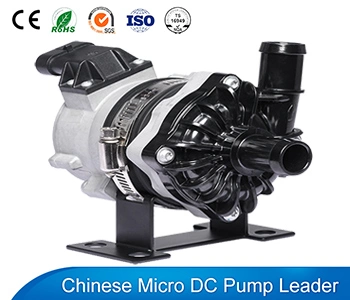
Main Parameters (VP80E)
| Rated Voltage: | 13.5V/24V/24V |
| Max Static Head: | 10 Meters/10 Meters/14 Meters |
| Max Flow Rate: | 50L/Min / 50L/Min / 50L/min |
| Inlet Outer Diameter: | Φ20mm |
| Outlet Outer Diameter: | Φ20mm |
| Liquid Temperature: | -40°~125°C |
| Certificates: | ROHS,CE |
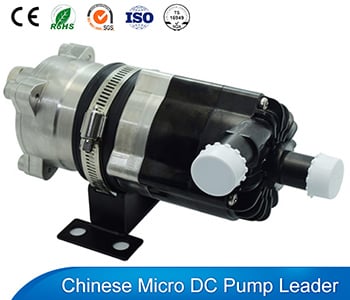
Main Parameters (VP75A Explosion Proof)
| Rated Voltage: | 24V |
| Max Static Head: | 5 Meters |
| Max Flow Rate: | 40L/Min |
| Inlet Outer Diameter: | Φ20mm |
| Outlet Outer Diameter: | Φ20mm |
| Liquid Temperature: | -40°~125°C |
| Certificates: | ROHS,CE |
■ Related Products
Table of Contents
Why an electric coolant pump should be used in automobile?
Nowadays, with the hot sales of turbocharged engines, the cooling system has become another major problem faced by major automotive manufacturers. Due to the turbocharger runs too fast, up to 200,000 rpm max speed, plus the exhaust gas temperature. It will cause the turbine temperature to reach about 1000 °C. The oil and coolant will stop flowing, and the high temperature of the turbine cannot be effectively cooled. Once the driver turn off the engine and the engine stops. Over time, it is easy to accelerate the aging of the turbine. And the oil in the bearing shell will overheat, forming coking, resulting in excessive oil consumption. In order to solve this drawback,extend the engine life ,as a high efficiency brushless dc pump the engine electric coolant pump come out.
What is the main function of Electric coolant pump?
The main function of the 12v coolant pump is that: As a circulation water pump, the 12v engine coolant pump will keep working to continue the circulation of the coolant to fully dissipate heat for the turbocharger, after the engine stopping work. Its working principle is: It is controlled by the engine control unit, the electric coolant pump helps the engine turbocharger to cool under certain operating conditions; The electric water pump discharges the heat away from the turbocharger, after the driver turn off the engine.
That is to say, during the driving process, the engine control unit ECU will automatically adjust according to different working conditions. So as to avoid excessive heat generated by the turbocharger to damage the turbocharger. The electric coolant pump will continue to work automatically for a while. After the driver turn off the engine directly from driving at a high speed for a long time. This can eliminate the faults of the turbocharger due to overheating. In addition, it will stop working according to the situation and achieve the purpose of energy saving. If the control unit detects that the engine is not under heavy load conditions.
What hazard are there to the engine caused by the damage of the engine coolant pump?
How to judge the automotive coolant pump is damaged or not?
Since the frequent use of automotive coolant pump, it is unable to avoid that they will not fail during operation. Therefore, people should master the diagnosis and maintenance methods of common failures of the pump, eliminate the failures in time to avoid damage to the car engine. So, how to judge the electric coolant pump is damaged? People can judge it from the following aspects:
- Idle speed is unstable: the failure of the electric coolant pump can lead to the rotation resistance increased. Since the coolant pump connects with the timing belt, the increase of the rotation resistance of the coolant pump can directly affect the rotation of the engine. It manifests the pulsation of the speed after starting, when in idling. Which is more obvious in winter and can even cause the engine flameout.
- Noise of the engine area: This sound is a rotating friction sound, similar to the sound of buzzing sound. This kind of sound will accelerate with the rotation of the engine. The changes in the volume of the sound happens, this noise is more and more obvious along with the fault increased.
- The engine water temperature is unstable: It manifested, the engine water temperature indicator needle fluctuates within a certain range. The reason is that the water temperature in the small cycle is inconsistent due to lacking of circulation. On the one hand, it lead to the open temperature of the thermostat rose. On the other hand, the low temperature water quickly flows to the thermostat, after the high temperature water flows out. So that close the thermostat quickly.
How to choose coolant for automotive electric coolant pump?
As we know, if coolant contains solid particles and its size are too large. In addition to extremely high-speed impact on the impeller and destroying the original anti-corrosion protective layer, it will use the heat that released when the bubbles condense to chemically corrode the impeller’s surface material. And the development of corrosion is extremely rapid, which greatly accelerates the destruction speed of the impeller material of the automotive electric coolant pump. Even in the case of weak cavitation, cavitation plus corrosion stress will seriously damage the blade material. Severely, the large size solid particles will cause the electric coolant pump impeller stuck and burn the coolant pump motor. Therefore, we must choose a qualified coolant for the electric coolant pump. People can choose a qualified coolant follow the below points:
1. Check the outer packaging and its description.
Check the product name, registered trademark, main performance indicators (such as freezing point, boiling point), manufacturer, factory address, production date, contact number and other items on the package in detail. Regular products are fully clear marked; Fake and inferior products are not fully marked or the packaging marks do not match inside and outside.
2. Smell and see the color.
Qualified coolant has a clear and transparent appearance, and has eye-catching colors; low viscosity, good fluidity, and no peculiar smell. The inferior counterfeit products are mostly made of ethanol or methanol, or are configured from various fusel and other chemical wastes, with peculiar smell and no obvious color.
3. Pay attention to the choice of freezing point.
Under normal circumstances, the freezing point of the coolant should be selected to be about 10-15℃ lower than the local environmental conditions in winter. If the local minimum temperature is -30℃, then the coolant should be below -45. Otherwise, the coolant will freeze , lead to the the impeller of the automotive electric coolant pump stuck and burn the pump motor.
4. Identification of boiling point.
The boiling point is also an important indicator of the quality of the coolant. The more higher the boiling point is, the more difficult it is for the car boil happening. The boiling point of water is 100°C. The coolant should be at least 108°C, which means that the more lower the freezing point is. The more higher the boiling point is and the more greater the temperature difference is, the more better the quality of the coolant is. To identifying the boiling point, people can use a beaker to heat the coolant and measure its boiling point with a thermometer. Anything with a boiling point above 100°C is a genuine product, and a boiling point less than 100°C is a fake product.
5. Pay attention to the anti-corrosion function of coolant.
Generally speaking, regular manufacturers add preservatives, corrosion inhibitors, scale inhibitors and cleaning agents to the products that produced by them. So the coolant quality can be guaranteed. Of course, the quality of coolant is not obvious at a glance. And the side effects of substandard products can only be revealed in a period of time and under certain conditions. For example, the freezing point of some products is marked -25℃, however, its actual freezing point is only -12℃. When the user uses the product at a temperature lower than -12℃, also the cylinder will in the danger of freeze and crack. Some products will corrode the tank, the automotive electric coolant pump and leak water after using for a period of time. Then water will enter the engine and cause the engine to stall, which will affect the normal operation, more seriously the engine body will be damaged, so people should observe it during use.
